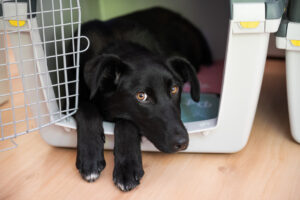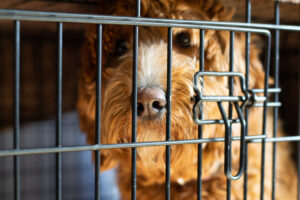The Ultimate Guide to Crate Training Your Dog: Tips, Benefits, and Mistakes to Avoid
Crate Training Your Dog: A Step-by-Step Guide
Understanding Crate Training
Crate training is a method where dogs are taught to become comfortable and secure in a crate or kennel. This technique taps into a dog’s natural instinct to seek out a den-like space for safety and relaxation. Furthermore, crate training is an effective tool for housebreaking, preventing destructive behavior, and providing a safe haven for dogs. Off Leash K9 Training, a reputable dog training company in Northern Virginia, specializes in crate training, utilizing their extensive experience and diverse training backgrounds to help dogs adjust to crate life.
To understand crate training, it is important to consider the benefits it provides to both dogs and their owners. When dogs are crate trained, they have a designated space that they can call their own, which can help reduce their anxiety and provide them with a sense of security. In addition, crate training can be a valuable tool in housebreaking a dog. Dogs naturally avoid soiling their sleeping area, so by confining them to a crate, it helps them develop bladder and bowel control. This can be especially useful during the puppy stage when accidents are more likely to occur.
Another benefit of crate training is that it can prevent destructive behavior. Dogs who are left unsupervised in a house or yard can often get into trouble by chewing on furniture, shoes, or other valuable items. By confining them to a crate when they cannot be supervised, owners can ensure that their dogs are not engaging in destructive behavior. Crate training can also be useful for transportation purposes, as dogs who are crate trained are typically more comfortable and secure during car rides or flights.
Benefits of Crate Training
The benefits of crate training are manifold. Notably, it promotes a sense of security and comfort for dogs, mirroring their instinctive desire for a den-like environment. Additionally, it aids in preventing accidents and destructive behavior by teaching dogs to control their bladder and to chew appropriate items. Crate training also facilitates easier transportation and travel with dogs, as a crate provides a familiar and safe space. Moreover, it offers dogs a dedicated place to relax and retreat when needed, thereby reducing anxiety. Off Leash K9 Training guarantees 100% obedience and off-leash training, ensuring dogs are well-behaved both inside and outside their crates.
One example of how crate training can benefit dogs is in situations where they may need to stay in a crate temporarily, such as during visits to the veterinarian or while traveling. Dogs who are accustomed to being in a crate are more likely to feel calm and secure in these unfamiliar environments. Additionally, crate training can be helpful in managing separation anxiety. Some dogs may become anxious or distressed when left alone, but by providing them with a crate as a safe and comfortable space, they can feel more at ease when their owners are away.
Crate training can also be beneficial for dog owners. For example, if a dog needs to be confined for a short period of time, such as when visitors come to the house or during meal times, a crate can provide a safe and controlled space. This can help prevent unwanted behaviors, such as jumping on guests or begging for food. Additionally, crate training can make traveling with a dog much easier. Dogs who are comfortable in their crates are more likely to be calm and well-behaved during car rides or flights, reducing stress for both the dog and the owner.
Step-by-Step Guide to Crate Training
Successful crate training involves several steps. Initially, it is crucial to choose the right crate size, considering the dog’s breed, age, and future growth. The crate should be large enough for the dog to stand up, turn around, and lie down comfortably, but not so large that they can use one end as a bathroom area. The crate should also be made of sturdy materials and have proper ventilation.
Once the right crate has been selected, it should be introduced gradually to the dog. The crate should be placed in an area of the house where the dog spends a lot of time, such as the living room or bedroom. The door to the crate should be left open so the dog can freely explore it at their own pace. Treats and praise can be used to encourage the dog to enter and stay in the crate. It is important to make the crate a positive and inviting space for the dog, so providing comfortable bedding and a few toys can help make it more appealing.
Creating a consistent crate training schedule is also important, including designated times for meals, potty breaks, and playtime outside the crate. Gradually, the duration of crate time should be increased, ensuring the dog remains comfortable and relaxed. It is important to never force the dog into the crate or use it as a form of punishment. The crate should always be associated with positive experiences and should never be a place of fear or anxiety for the dog.
Off Leash K9 Training’s experienced trainers can provide guidance and support throughout the crate training process, ensuring that both the dog and the owner feel confident and comfortable with the training. By following a step-by-step guide and utilizing the expertise of professional trainers, crate training can be a successful and positive experience for both dogs and their owners.
Common Mistakes to Avoid in Crate Training
There are several common mistakes to avoid during crate training. These include leaving dogs in the crate for extended periods, which can lead to anxiety and discomfort, and using the crate as a form of punishment, which can create a negative association. It is important to remember that the crate should be a safe and comfortable space for the dog, and it should never be used as a way to isolate or punish them.
Another common mistake is not making the crate a positive and inviting space. Dogs should have access to comfortable bedding, toys, and water while in the crate. This will help them associate the crate with positive experiences and make them more likely to willingly enter and stay in the crate. Additionally, it is important to avoid rushing the crate training process. Each dog is unique and may take different amounts of time to become comfortable with the crate. Patience and consistency are key.
Off Leash K9 Training guides dog owners to circumvent these pitfalls for successful crate training. Their trainers can provide valuable tips and advice on how to avoid common mistakes and ensure that the crate training process goes smoothly. By being aware of these common mistakes and taking steps to avoid them, dog owners can set their dogs up for success in crate training.
Crate Training Tips for Puppies and Adult Dogs
When crate training puppies, start with short crate sessions and gradually increase the duration as they develop better bladder control. Puppies have smaller bladders and higher energy levels, so they may need to be let out more frequently than adult dogs. It is important to take them outside to use the bathroom before and after crate time, as well as during any breaks throughout the day.
To keep puppies engaged and stimulated while in the crate, age-appropriate chew toys and interactive feeders can be used. These toys can provide mental stimulation and help prevent boredom, which can lead to destructive behavior. It is important to choose toys that are safe and durable, as puppies may chew on them for extended periods of time.
For adult dogs, ensure they have regular exercise and mental stimulation to prevent restlessness in the crate. Adult dogs may have more control over their bladder and be able to hold it for longer periods of time, but they still need regular breaks for bathroom breaks and exercise. Providing them with plenty of physical and mental exercise before crate time can help reduce restlessness and make the crate a more comfortable space.
Off Leash K9 Training’s trainers employ these specialized techniques for crate training puppies and adult dogs. They can provide personalized tips and advice based on the specific needs of each dog, ensuring that the crate training process is effective and tailored to the individual dog. By following these tips and utilizing the expertise of professional trainers, dog owners can successfully crate train both puppies and adult dogs.
Crate Training in Northern Virginia with Off Leash K9 Training
Off Leash K9 Training is a reputable dog training company that specializes in crate training and offers personalized training programs for dogs of all ages and breeds. Their experienced trainers have a deep understanding of crate training techniques and can provide guidance and support to dog owners throughout the training process. By working with Off Leash K9 Training, dog owners in Northern Virginia can ensure that their dogs receive the highest quality crate training and are well-prepared for a happy and well-behaved life both inside and outside of their crates. For more information, interested individuals can reach Off Leash K9 Training at (571) 252-5536 or visit their website at offleashk9nova.com.




